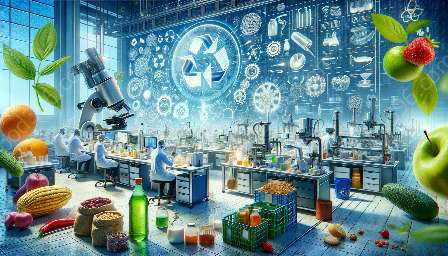Nanotechnology has emerged as a revolutionary tool in the food industry, offering innovative solutions for food preservation, safety, and quality. By harnessing the unique properties of nanomaterials, researchers and food scientists are uncovering new ways to extend the shelf life of perishable foods, enhance food packaging, and mitigate the risk of foodborne illnesses. This article explores the intersection of nanotechnology and food preservation, delving into its applications, benefits, and future prospects.
The Science Behind Nanotechnology in Food Preservation
Nanotechnology involves the manipulation of materials at the nanoscale, typically ranging from 1 to 100 nanometers. This level of precision allows scientists to engineer structures and systems with novel properties that can be harnessed to address food preservation challenges. One of the key applications of nanotechnology in food preservation is the development of nanomaterial-based coatings and films to enhance the barrier properties of food packaging, thereby reducing oxygen and moisture permeability and preventing spoilage. Additionally, nano-sized antimicrobial agents, such as silver nanoparticles, have shown promising results in inhibiting the growth of pathogenic bacteria and extending the shelf life of fresh produce and meats.
Nanotechnology in Food Safety
Foodborne illnesses pose a significant public health concern, prompting the need for advanced strategies to ensure food safety. Nanotechnology offers a multifaceted approach to food safety by providing innovative tools for pathogen detection, decontamination, and traceability. Nanosensors equipped with molecular recognition elements can detect minute traces of contaminants in food, enabling rapid and sensitive identification of harmful substances. Furthermore, the application of nanomaterials, such as titanium dioxide nanoparticles, in food packaging has been linked to improved microbial inactivation, offering an additional layer of protection against foodborne pathogens.
Benefits of Nanotechnology in Food Preservation
The integration of nanotechnology in food preservation presents numerous advantages, including:
- Extended Shelf Life: Nano-based packaging materials can retard the degradation of food products, prolonging their shelf life and reducing food waste.
- Improved Safety: Nanomaterials with antimicrobial properties can effectively inhibit the growth of pathogens, enhancing food safety and reducing the risk of contamination.
- Sustainable Solutions: Nanotechnology enables the development of eco-friendly and sustainable packaging alternatives, thereby contributing to environmental conservation and resource efficiency.
- Enhanced Quality: Nano-encapsulation techniques can preserve the sensory attributes and nutritional quality of foods, ensuring optimal consumer experience.
Future Prospects and Challenges
The ongoing research and development in the field of food nanotechnology hold great promise for the future of food preservation. However, as with any emerging technology, several challenges and considerations must be addressed, including regulatory frameworks, consumer acceptance, and potential environmental impacts. Collaborative efforts among researchers, industry stakeholders, and regulatory bodies are essential to ensure the responsible and safe integration of nanotechnology in the food supply chain.
Conclusion
Nanotechnology has the potential to revolutionize food preservation practices, offering innovative solutions to enhance food safety, extend shelf life, and mitigate food waste. As the field of food nanotechnology continues to evolve, it is imperative to prioritize responsible innovation and knowledge dissemination to realize the full spectrum of benefits while addressing potential concerns. By embracing the principles of sustainable development and safety assurance, nanotechnology can pave the way for a more resilient and resource-efficient food system.
Food Nanotechnology, Food Science, and Technology.

